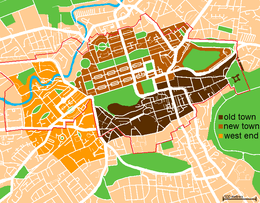Seafield, Edinburgh
Seafield is a coastal strip situated on the Firth of Forth between Leith and Portobello in north-east Edinburgh, Scotland. The area is mainly commercial, and has little housing.

The area is home to Edinburgh Dog and Cat Home, which cares for around 150 of Edinburgh and the Lothians' lost and abandoned cats and dogs.
The Eastern General Hospital was based here until being demolished in 2008.[1] Its maternity unit served North East Edinburgh and the Borders until 1997.[2]
Seafield Cemetery and Crematorium

Dating from 1889 the cemetery has an impressive entrance lodge and gates in the style of Kinross House. The crematorium dates from 1938 and was designed by the Leith architect W. N. Thomson.[3] The cemetery has a columbarium and Italian style section to the south. There are few notable monuments or interments:
- Bernard Hunter, businessman
- Thomas Bernard Mouat surgeon and medical author
- Robertson Fotheringham Ogilvie FRSE pathologist
- Rev David Brown Spence, missionary
- Raimondo Nicolo de Pinto and John James de Pinto, Greek consuls
There are a high number of war graves, partly due to the cemetery's proximity to the Eastern General Hospital, which served as a military hospital during the Second World War. There are also a number of trawlermen buried in war graves, due to the government conscripting both boats and crews to serve in mine clearance duties during the First World War. The crews were officially part of the Royal Navy Reserve during this period.[4] Here are buried 185 Commonwealth service personnel of the First World War, some buried in the Military Plot in Section B or the Admiralty Plot in Section M, otherwise scattered throughout the cemetery. Those whose graves could not be marked are listed on a Screen Wall memorial. There 104 service personnel from the Second war, including 5 unidentified sailors, many buried in a plot in Section P, facing which is a memorial to 22 service personnel of the latter war cremated at the crematorium.[5]
References
- Buildings of Scotland: Edinburgh by Gifford, McWilliam and Walker
- "Eastern General".
- Buildings of Scotland: Edinburgh by Gifford, McWilliam and Walker
- The War at Sea: WW100 Scotland
- https://www.cwgc.org/find-a-cemtery/cemetery/47117/edinburgh-(seafield)-cemetery.
